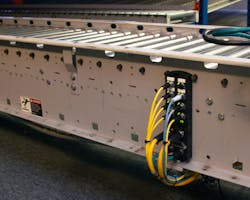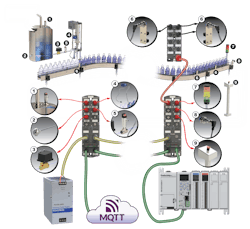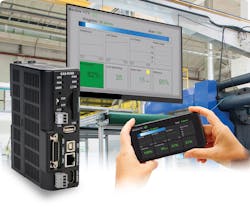Distributed automation enables elimination or shrinking of control panels
Control panels, used to enclose and protect automation components, have been a longstanding essential for OEM machines and industrial manufacturing operations. However, several evolving technologies have intersected in ways that are prompting designers to reconsider how and where they deploy control panels and enclosures.
Electronics have become smaller and more capable of surviving harsh environments. Better field networking options, like IO-Link, are making field-located input/output (I/O) more practical, and often the preferred solution. Taking this a step further, wireless connectivity and mobile devices are changing how field devices can connect, and how operators can visualize and interact with automation systems and associated control panels.
Enclosures and control panels remain relevant, and designers can refer to other articles to find out more. But process automation designers need to increasingly consider additional approaches that may minimize, or even avoid, the use of enclosures and control panels.
Big box automation
Traditional automation architectures have consisted of field devices — such as sensors, instruments and actuators — hardwired to I/O modules. The I/O modules might be located in one or more remote enclosures, or they could be co-located in a main control panel with the programmable logic controller (PLC). Human-machine interfaces (HMIs) could be installed in any of these control panels, depending on the need for operator access.
In addition to these automation system requirements, enclosures are typically needed for electrical distribution and other power handling tasks, such as for motor controls.
Although most of the electronics involved are quite robust and intended for industrial service, they may not be made to withstand the elements or be installed in an “open” manner. Therefore, designers must evaluate many constraints when selecting enclosures for industrial automation products, including:
- Size: Choosing a size small enough to fit in constrained locations, yet large enough to house devices and provide working space for field maintenance personnel.
- Protection: Ensuring the enclosure will protect against environmental elements ranging from dust to water in varying degrees, and perhaps even providing resistance to chemicals.
- Connectivity: A multitude of power and signaling connections, each hardwired to an enclosure, require appropriate space for conduit and cable ingress/egress, while maintaining environmental ratings.
- Thermal management: Components within an enclosure can only tolerate a certain temperature range, and often generate heat themselves. Combined with external temperature conditions and solar loading, devices such as heaters, fans and air conditioners are often needed to regulate the temperature.
- Cleanliness: For food and beverage and life sciences applications, enclosures might be subjected to high-pressure and high-temperature water/chemical washdowns, and they need to be designed to not harbor any form of contamination.
- Safety: Enclosures offer a convenient way to protect users from electrical and other hazards, and a way to restrict access to only authorized users.
Enclosures are continuing to serve these important roles, but developing automation technologies have resulted in improvements.
More flexible functionality
Modern industrial automation components have been trending smarter and smaller for decades. Combined with improved field and factory networking methods, and the fact that some devices are designed to mount openly in a standalone manner in the field, designers now have a multitude of options to reshape the nature of OEM and factory automation systems. The following are a few examples.
Wireless Ethernet and Bluetooth
Ethernet has become a predominant networking method for use with controllers, operator interfaces and other industrial devices. While Ethernet was originally a wired technology, Wi-Fi versions are now supported by many industrial components. Bluetooth is used by some devices to provide localized access for personnel.
Together, these wireless technologies mean that so long as power is available, various components can be easily distributed throughout a machine or a factory, located right where they need to be, without additional networking connections among them. While this sometimes entails the installation of small external antennas, the use of non-metallic enclosures such as fiberglass and polycarbonate, which do not impede the wireless signals, allow internal installation of devices designed to send and receive wireless signals.
IO-Link and other fieldbuses
To reduce the amount of field wiring, and provide enhanced data connectivity, there are many established fieldbuses such as Modbus, PROFIBUS and DeviceNet. Some of them use specialized media, and newer versions — such as Modbus TCP, PROFINET and EtherNet/IP — use Ethernet media.
A more recent development, and one particularly suitable for industrial OEM and factory installations, is IO-Link, which is specified by IEC 61131-9. This cost-effective standard provides practical digital connectivity with benefits such as:
- Bidirectional communications.
- Rapid and reliable transmission of up to 32 bytes of data, including process values, configuration settings and diagnostics.
- Installation lengths of up to 20 meters, using standard three-wire cables.
- The ability to supply normal 24V DC power, and for devices to operate as traditional on/off or 4-20mA if desired.
Some IO-Link networking devices are installed in control panels, but many are made to be surface-mounted on machinery. These devices can be obtained with potted housings rated at IP67, and using key-coded M12 connectors, making them suitable for open installation as needed (Figure 1).
A wide variety of common field devices such as photoeyes, proximity sensors, transmitters, solenoids and more are available with native IO-Link connectivity. Many designers are finding that the IO-Link standard has become the right-sized approach for digitally transforming their installations with smarter field devices and an easy-to-use architecture, while minimizing the size and number of control panels (Figure 2).
End users benefit from this architecture thanks to IO-Link’s ability to automatically configure replacement devices, allowing maintenance personnel to swap out defective or damaged field devices without relying on automation personnel.
Washdown-rated VFDs
Many electrical power devices, especially motor controls like variable speed drives (VFDs), have typically required installation in an enclosure or an environmentally protected electrical room. Because these devices generate heat and electrical noise, they are problematic to install in field enclosures, especially near other control components. However, it is very desirable to use VFDs in many equipment applications for better control, reduced energy usage, minimized wear on hardware and advanced data acquisition.
Newer VFDs rated at NEMA 4X, and with support for communications such as Modbus TCP and EtherNet/IP, now provide a solution for applications up to about 40 HP. They are especially useful for food and beverage and life science installations, but they are also often the best option for mounting directly on conveyors or other remote equipment near the motor, which saves on installation costs. Additionally, many of these washdown-rated drives include an integrated disconnect handle, allowing maintenance workers to quickly and safely lock out a drive without needing to open a cabinet.
Some VFDs include on-board controllers so they can operate independently from a supervisory control system. Even when operated in conjunction with a main control panel, users only need to install power to the VFD, and an Ethernet connection between the VFD and the PLC.
Mobile HMI
Mobile devices such as smartphones and tablets are basically handheld computers, and users are comfortable using these for a wide range of activities, so it makes sense that mobile connectivity for industrial HMI use is on the rise.
There are many implementation options. A traditional local HMI can serve up displays to mobile devices. PLCs and/or HMIs can use the MQTT publish/subscribe protocol to transmit data up to on-premises or cloud-based brokers, for consumption by any number of mobile devices. Or designers can take advantage of “headless” HMIs which can be installed anywhere in an enclosure on the machine or in the factory, and then serve up displays and data to handheld devices (Figure 3).
Evolving automation becomes distributed
Automation technologies of all types are becoming smarter and smaller, and some products are now made specifically for on-machine and field mounting. Improved data connectivity, increased flexibility and serviceability, and enhanced performance are all important drivers when implementing distributed automation technologies.
Many OEMs and systems integrators are moving outside the box to capture total overall installed savings due to minimized field wiring. Control panels and enclosures are still used, but often in a somewhat minimized role as newer technologies are adopted.
Chris Kregoski is a product engineer at AutomationDirect in Cumming, Georgia, on the Productivity PLC development and support team. He spent nearly a decade as the owner of Woodwest Controls, a small system integrator, servicing start-ups in the malting, brewing, distilling and water treatment industries.
AutomationDirect
About the Author
Chris Kregoski
Product engineer at AutomationDirect
Chris Kregoski is a product engineer at AutomationDirect in Cumming, GA., on the Productivity PLC development and support team. He spent nearly a decade as the owner of Woodwest Controls, a small system integrator, servicing start-ups in malting, brewing, distilling and water treatment industries.


